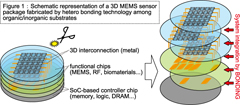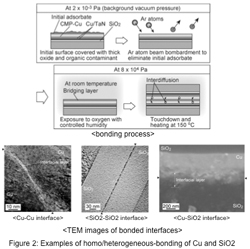Dr. Akitsu Shigetou
Vapor-assisted low-temperature bonding method for 3D hetero-integration of organic/inorganic MEMS substrates
Akitsu Shigetou
shigetou.akitsu@nims.go.jp
Functional Interconnection Group, Hybrid Materials Center
団体情報:
Institute for Advanced Micro-System Integration (IMSI)
http://www.su.t.u-tokyo.ac.jp/~imsi/
Japan Institute of electronics packaging (JIEP),
http://www.e-jisso.jp/
最新情報:
エレクトロニクス実装学会 優秀講演賞 2006 (JIEP Excellent Paper Award),エレクトロニクス実装学会 研究奨励賞 2009(JIEP Award for Encouragement of Research)
概要:
In this research work, the vapor-assisted bonding method, which is applicative to diverse materials including metal, glass, and polymers at 150 °C at atmospheric pressure, is being developed. In particular, homo/heterogeneous bonding of Cu and SiO2 was recently realized using vapor-assisted surface activation method. Considering the potential requirement of mixed integration of non-heat-resistant substrates such as polymers and bio-inert materials used in MEMS sensor systems as shown in Figure 1, such a bonding technology is expected to be effective in generating high bond strength on both the electrodes and the insulation layer at the same time. Although the research content is not directly related to so-called "biomimetics," this bonding method can be categorized as the bridging technology between conventional electronics components and novel functional nature-inspired materials.
In such a bonding technology, the process should be performed on the premise of adsorbate layer on clean surfaces. That is, to create high binding energy on metallic-bond and ionic-bond materials by single process in such an adsorptive condition, the chemical binding status on the outmost surface had to be well controlled. Concretely, we have to modify the thickness and chemical composition of adsorbate after the dry-etching-based surface cleaning process is carried out, because sufficient volume diffusion of inner atoms across the interface is necessary. For Cu and SiO2, humidified oxygen was used as the bonding process atmosphere, because it was proven that the water molecules in collision with the Cu surface provoked the formation of adhesive bridging layers such as hydrate onto unsaturated coordinate site on Cu and Cu oxide. For the SiO2 surface, the effect of hydrophilic bonding was obtained at the same time.
The schematic representations of the bond process and the TEM images of bonded interfaces are shown in Figure 2. First we investigated on the influence of water adsorption on the growth behavior of adsorbate on atomically clean surfaces. Nitrogen gas condition was used to discuss the influence of water separately from that of oxygen. The X-ray photoelectron spectroscopy (XPS) results identified that the bridging layers for Cu and SiO2 included oxide, hydroxide hydrate, and silanol groups, respectively. The angle resolved testing showed that thickness of bridging layers increased concomitantly with absolute humidity. In addition, these layers were considered to contain intermolecular-bound water, which would derive the additional phsisorption of water molecules in ambient air. Upon heating at the temperatures higher than 100 °C, high die-shear strength was obtained at the interfaces of Cu-Cu, Cu-SiO2, and SiO2-SiO2 due to the dissociation of water molecules. TEM observations showed that, in particular at the Cu-Cu interfaces, the amorphous interfacial layers were created in increasing thickness with absolute humidity. In such amorphous layers, recrystallization of CuO grains was observed during the storage in ambient air at room temperature. With a controlled thickness of this oxide layer, mean contact resistivity of less than 4 x 10-8 m was successfully obtained.

figure 1

figure 2



